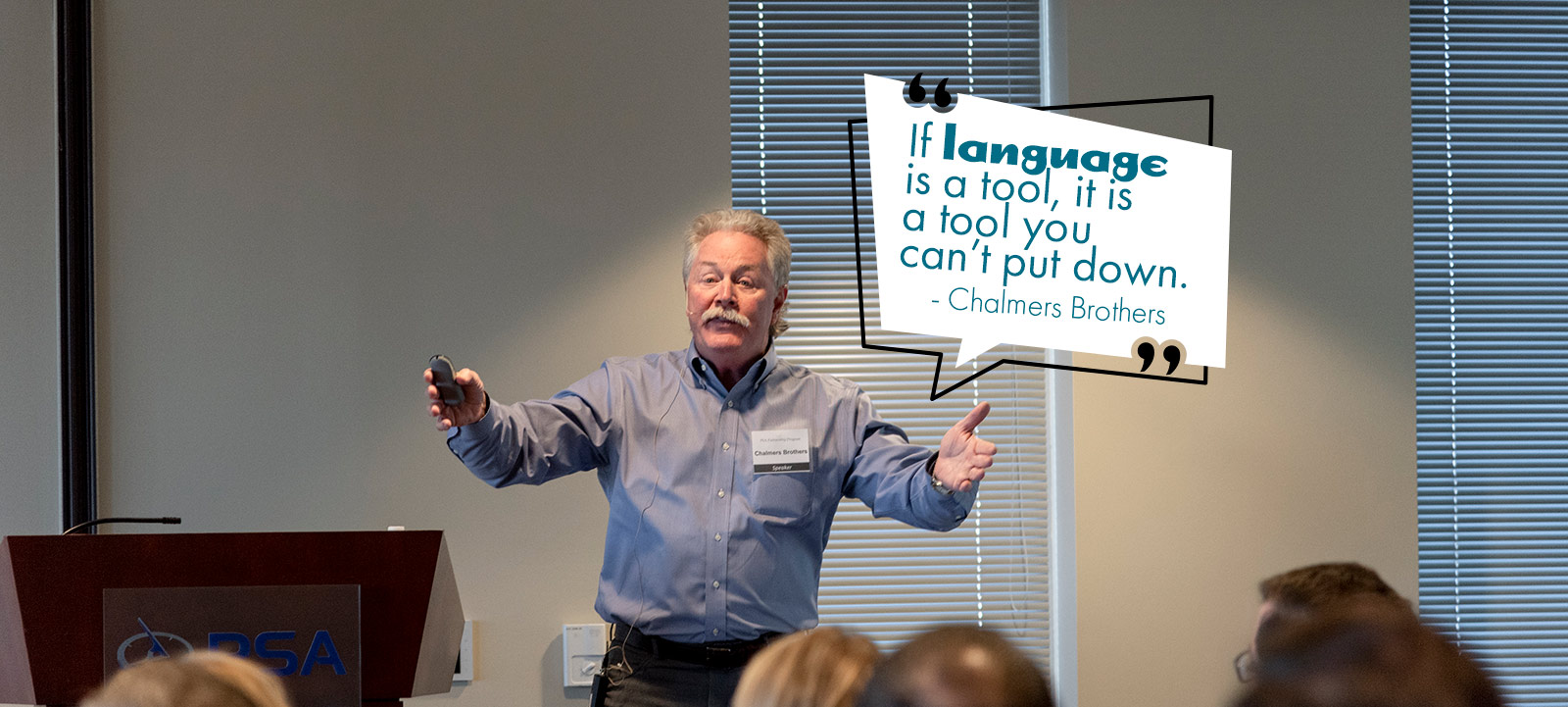Leadership Language: Executives, Speak the Results You Want into Action
Posted in: PSA Partnership
In the words of Einstein, “not everything that counts can be counted.” Such is the case when it comes to leadership language and how you wield it within your professional relationships. At a recent PSA Partnership Seminar, Chalmers Brothers, best-selling author, certified executive coach, and international speaker, challenged company leaders and executives to examine their beliefs about leadership language.
When you boil a leadership role down to its core, you get paid to have conversations. You are what Chalmers refers to as a “conversational architect.” If this is the case, and if you currently view language as just a tool, you may need to re-evaluate what language is and does. Language is more than just a tool, in fact, according to Chalmers,
“
If language is a tool, it’s a tool you can’t put down. It’s a tool you need to use every other tool.
”
You get paid to be a conversational architect to achieve results—both quantitative and qualitative. For example, your leadership language (intentionally or unintentionally) creates company culture and identity as well as profits.
We all live in language
While your external language is important to your company’s success, even more vital are the internal conversations you have with yourself. You are constantly confronted by events. Whether you acknowledge it or not, you create and believe stories about these events, which drive your actions. Your explanation of an event is always the impetus for your actions, rather than the actual event itself. Your actions, created by the explanations you believe, produce results for your company (favorable or not).
According to Chalmers, if you don’t have this crucial separation between knowing that you create stories, but that the event does not always equal your explanation, then “authoring a more powerful option will never occur to you.” You need to be able to shift your thinking and “show your work”—figure out how you got from the event that happened to your explanation.
As a leader, ask yourself this: are your explanations helpful or unhelpful? Are they effective or ineffective in achieving the results that you want? If you always do and believe the same, old things, you’re always going to keep getting the same results.
Leadership language creates and generates
“Language is the actual how” according to Chalmers. It’s how we get from ideas and strategies to results and change. So, knowing that times are always changing and that learning in times of change is crucial, is it frowned upon to say “I don’t know” in your company? It’s imperative that you allow and encourage people to ask questions. It’s up to you to create the space necessary for innovation and creativity to grow.
To that end, the conversations that you require and forbid can shape your company culture. When performance isn’t where you’d like it to be, look at these conversations, and more importantly, look for any conversations that may be missing in your infrastructure. Are there things that should be said during onboarding to inform new employees of culture and expectations? Are you having meetings after which a subgroup of the attendees have the real meeting in the breakroom? The only way you’ll find out is to ask your employees for their honest feedback in a context where they feel comfortable responding.
Ambitious people want to hear constructive criticism, as long as it is in a context of respect and truth. If you invite your employees to give you feedback about your meetings and even your leadership style, you may not hear what you know is the truth, but that doesn’t mean that they aren’t being honest about how they perceive you. Even if what you hear conflicts with what you know to be true about yourself, you have collected important data about the persona you project at work.
Applying effective leadership language
So you’re realizing that language shapes and impacts everything you do, and that the conversations you have (both internally and externally) are what drive your company outcomes. How do you create the right context for hard conversations? How can you make changes to your conversations to achieve different, more positive results? Here are some practical suggestions:
- Purposefully create an authentic context. People want to know that you are genuine in your desire for feedback and that they won’t be punished for their honesty.
- If you need to have a hard conversation, approach it as a “carefrontation.” Let the person know that you care enough about them and the company to have an uncomfortable, but potentially extremely valuable conversation with them.
- Set expectations before the conversation occurs. If you’re looking for feedback, ask specific questions up front. For example, at the beginning of a meeting, let the group know what you’re hoping to accomplish, in how much time, and that you’d like them to rate certain things.
- Check listening at the end of a meeting. Just because you successfully said what you rehearsed does not mean that your employees will all walk away with the same message. Every person is a “unique observer;” and therefore, they cannot and do not see things the same way you do. To ensure everyone is on the same page, ask each person what was just agreed upon at the end of a meeting.
Want to keep the leadership conversations going? Join us for our next Partnership event on June 25, “Short-Circuiting Burnout,” presented by Dominick Quartuccio. This seminar will help you and your teams understand how to break through self-imposed ceilings that lead to burnout and plague organizations with procrastination, disengagement, and diminishing work quality.



